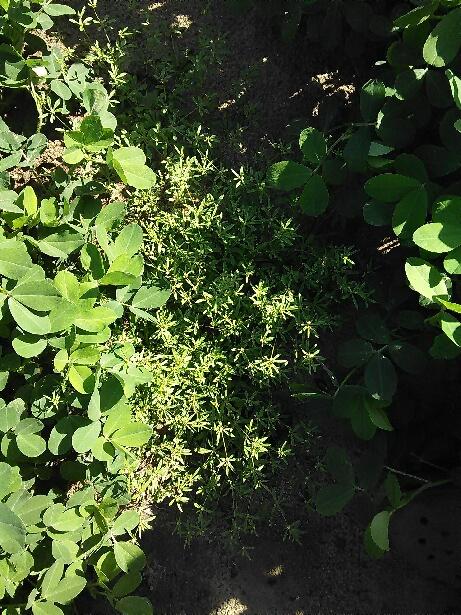
by Mark Tancig | Jul 5, 2016

When you don’t know what’s ailing your plant, ask an expert.
Many gardeners get stumped when a favorite plant of theirs comes down with a strange “something”. Many of these gardeners know about UF/IFAS Extension and call their local horticulture and agriculture agents for assistance in figuring out what’s going on. However, even these experts are often stumped by what they see. Fortunately, the agents have another layer of experts to fall back on. In addition to the resources in Gainesville, we have the Plant Disease Diagnostic Clinic, located at the North Florida Research Center in Quincy. Plant pathologists here can help determine what fungus, bacteria, virus, or viroid may be the problem.
Plant pathologists are basically plant doctors. They use all sorts of sophisticated techniques to determine what is the cause of a particular plant problem, from growing out fungal spores to examining DNA. Not only do these plant doctors tell us what the ailment is, they also provide recommended cures, or control options. They are also doing research to prevent different diseases from taking hold in our area and reduce the impact on our local growers.

Plant pathologist at work!
At a recent workshop in Quincy, we learned that plant pathology researchers are working on a fungus that affects watermelons, virus and bacteria that can wipe out a farmer’s tomato crop, and a virus that could impact our local roses. Working as a team of scientists, they study these pathogens in the lab and conduct controlled field experiments to figure out which techniques are most effective. Some of this research is leading to different methods and/or products that can help growers and gardeners alike keep their fields and landscapes healthy.
So, if your plants have problems, please contact your local Extension Office. If they don’t know the answer, then the network of scientists, including plant pathologists, in the UF/IFAS Extension family can be called on for backup to provide you with the best possible answer.
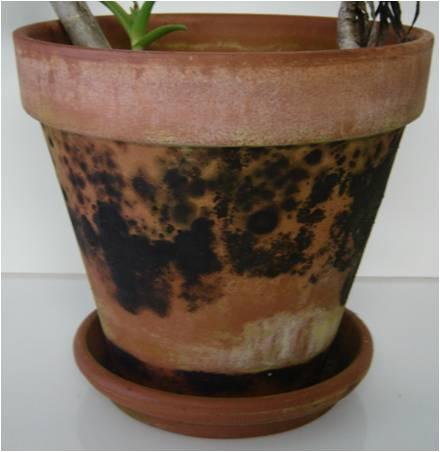
by Alex Bolques | Jul 28, 2015
Most likely, we all have them-garden pots. These typically are made of plastic, clay or wood. Garden pots should be sanitized if they were previously used or if they exhibit signs of mold or fungal growth. Whether they are used as garden boxes, planters, or hanging baskets, the surfaces of garden pots can harbor disease organisms, along with unsightly stains and mineral salts deposits. Salts from hard water and fertilizers can leach though clay pots leaving a white film on the pot’s outer surface. Salts accumulation can become flaky and encrusted around the rim and drainage holes of plastic and clay containers.

Mold or fungal growth on an unglazed terra-cotta (clay) pot Photo Credits: Alex Bolques, FAMU Research
To clean clay or plastic containers, use a brush or fine steel wool to remove dirt and debris and wash with a liquid soap detergent. If stains persist, consider using a 50:50 solution of water and vinegar. To sterilize clay or plastic pots, soak them in a mild solution of bleach, 1:10 bleach to water, for about 30 minutes. Then, immerse them in clean water and allow them to dry completely. Containers made of wood are different. If the timber that they are made of is not treated properly, they tend to rot and can harbor disease spores or bacteria. It is best to replace these as they show signs of wear or deterioration. Sanitizing your garden pots will help you avoid unwanted disease problems and unsightly garden container pots.

by Taylor Vandiver | Feb 17, 2015
Valentine’s Day has come and gone. You were likely showered with gifts from loved ones; gifts covered in chocolate, gifts of the stuffed variety, and more than likely the kind covered in petals. And as you languish in the afterglow of affection it would be wise to remember that your bouquets will need to be shown some affection if you intend for them to remain beautiful.
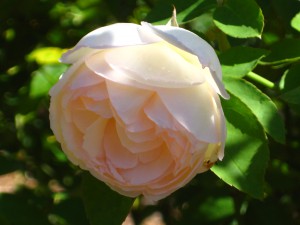
Duchesse de Brabant, Tea Rose. Photo Courtesy David Marshall.
Fresh cut flowers are a popular gift for Valentine’s Day and a simple, yet elegant way to relay your affections. Flowers have the capacity to brighten up a room and bring a smile to your face. The myriad of colors and scents are admittedly irresistible. However, after a few days your once overflowing vase may seem wilted and despondent. Follow these easy steps to increase the lifespan of your flowers and extend their potent powers!
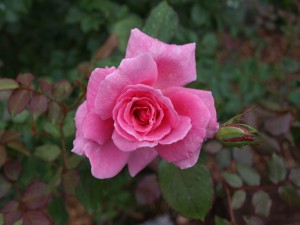
Carefree Beauty, Shrub Rose. Photo Courtesy David Marshall.
- Re-cut the flower stems using a sharp knife or shears. Remove at least one-half inch of stem to expose a fresh surface. Stems, especially rose stems, should be re-cut under water. A freshly cut stem absorbs water freely, so it is important to cut at a slant to avoid crushing the stem and to prevent a flat-cut end from resting on the bottom of the vase.
- Put flowers in water as soon as possible. Maximum water uptake occurs in the first 36 to 48 hours after cutting flowers. Place stems in 100-110°F (38-40°C) water, because warm water moves into the stem more quickly and easily than cold water.
- Make sure to remove any leaves from the stem that may be submerged. Because transpiration through leaves drives water flow up the stems of cut flowers, don’t strip all the leaves from the stem.
- Use a commercial flower food, they work best at controlling microbial populations, hydrating stems, and feeding flowers. Make sure you follow the directions on the floral preservative packet.
- Removing thorns from your roses may shorten their vase life. If damaged during the removal process flowers may be opened up to microbes that could slow down water conducting cells.
- If your vase solution begins to become cloudy, re-cut the stems and place into a new vase solution.
- Do not place flowers in direct sunlight, over a radiator, or on a television set. Heat reduces flower life since flower aging occurs more rapidly in high temperature conditions. It is important to avoid all drafty locations because warm or moving air removes water from flowers faster than it can be absorbed through the stems.
- Keep flowers away from cigarette smoke and ripening fruit, because they contain ethylene gas, which is harmful to flowers.
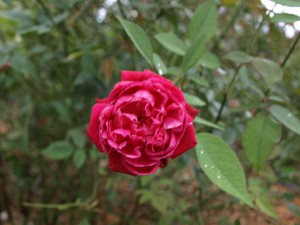
Louis Philippe, China Rose. Also known as the “old Florida rose” since it is found at many old historic Florida home sites and pioneer settlements. Photo Courtesy David Marshall.
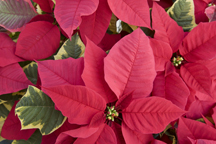
by Gary Knox | Dec 23, 2014
Poinsettias are one of the most popular plants during the Holiday Season. Poinsettias grow as shrubs in their native southern Mexico but have been bred to become compact, bushy plants perfect as container ornamentals. The showy “flowers” of poinsettias are actually modified leaves called bracts. Usually red in color, modern poinsettia breeding created showy bracts ranging in color from red to pink to white to orange, with lots of variegations and different leaf coloration patterns and sizes. The true flowers on poinsettias are the small green and yellow parts located in the center of each group of bracts.

Photo credit: Tyler Jones UF/IFAS.
Here are some do’s and don’ts to ensure that your poinsettias stay beautiful through the holidays and beyond:
- Do choose plants with true flowers that are greenish. Plants with unopened or newly opened flowers will last longer than those already sporting true flowers dusted with yellow pollen.
- Do choose plants that are bushy and leafy. Plants that have lost their lower leaves usually indicate the plant was mishandled and may decline quickly.
- Do place poinsettias in an area with bright light but not direct sunlight.
- Do keep poinsettias away from children and pets. Poinsettias are not poisonous but still might cause skin irritation and upset stomachs. People allergic to latex should be aware poinsettia sap contains latex-like materials.
- Don’t overwater poinsettias. Only water poinsettias when the top of the soil is dry, and let excess water drain away. Remove the poinsettia from the decorative foil wrapping to allow water to drain out.
- Don’t expose poinsettias to temperature extremes or drafty areas. Poinsettias like the same temperatures as people, so keep them away from cold (temperatures below 50) or heat (temperatures above 80).
After the holidays are over, you can plant poinsettias outdoors. For more information see:
Enjoy Your Poinsettias After the Holidays
In the meantime, enjoy your beautiful poinsettias and Happy Holidays!
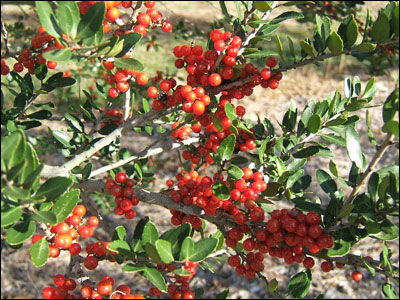
by Taylor Vandiver | Dec 16, 2014
Now that we’ve all been stuffed like a Thanksgiving turkey, it’s time to transition into the final and, arguably, most ornate holidays of the year. Right now you can hear your mantles and door frames crying out to be adorned. Your windows are begging for wreaths and giant red bows. And there may be a certain corner in your house that has been waiting all year for an evergreen, or two.
As we delve into the winter holidays our homes are being dressed to impress. There is nothing better than fresh foliage placed along a mantle or maybe a little mistletoe hanging from a previously unadorned beam. The scent of pine is in the air and I don’t know about you, but I’m ready to get decorating.
Here is a list of a few evergreen plants that make wonderful decorations for the season. You may even find some in your own backyard! Just make sure when you are removing foliage and fruit that you do it gently, so as not to harm the plant. Make all cuts at a 45 degree angle so that water will not pool on branch tips and rot. Also, if you forcefully remove foliage from a plant you could expose the susceptible cambium layer.

Wreaths and a decorated door frame add a bit of holiday cheer to this snowy scene. Photo courtesy Taylor Vandiver.
Traditional
Magnolia (Magnolia grandiflora) – This southern staple provides foliage that will liven up any banister or door frame. After being cut from the tree it can withstand the dryer temperatures indoors for days on end.
Hollies (Ilex spp.) – Hollies not only provide glossy green foliage, but bright red fruit that will beautifully adorn holiday arrangements and centerpieces.
Pine/Pinecones (Pinus spp.) – Pine trees offer a wispy presence to many decorations and their cones can give structure to wreaths and mantle pieces.
Boxwood (Buxus spp.) – Boxwoods are great for a touch of green.

Yaupon holly fruit and foliage. Photo courtesy UF/IFAS.
New Ideas
Abelia (Abelia x grandiflora) (evergreen to semi-evergreen) – Abelia are not commonly thought of when making holiday arrangements, but the texture of their foliage and the myriad of colors can spice up traditional decorations.
Aucuba (Aucuba japonica) – Aucuba offer a coarse texture that would pair well with the wispier pine foliage. Also, the gold dust variety will add a little more color to the mix.
Aspidistra (Aspidistra elatior) – Aspidistra foliage tends to feel more tropical. If you want to try a non-traditional arrangement these would work well and they can last for days provided a small amount of water.
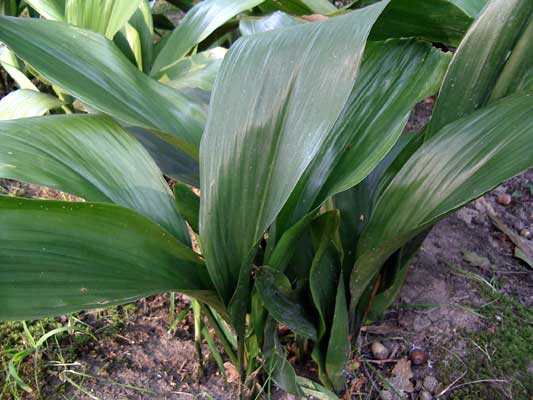
Aspidistra foliage that could easily be worked into a stunning arrangement.
Remember that a few well placed planters can liven up even the smallest spaces. Try using a small evergreen tree or shrub such as a magnolia, cypress / false cypress or arborvitae and surround them with poinsettia or pansies. You can try a smaller planter and add in pine cones, poinsettia, grasses, etc. Also if you are celebrating this holiday season with a live Christmas tree, then don’t be afraid to ask the grower/retail center for discarded branches. These can easily be formed into a wreath or used throughout the house. And since this is Florida there’s always the option of decorating your palm tree!
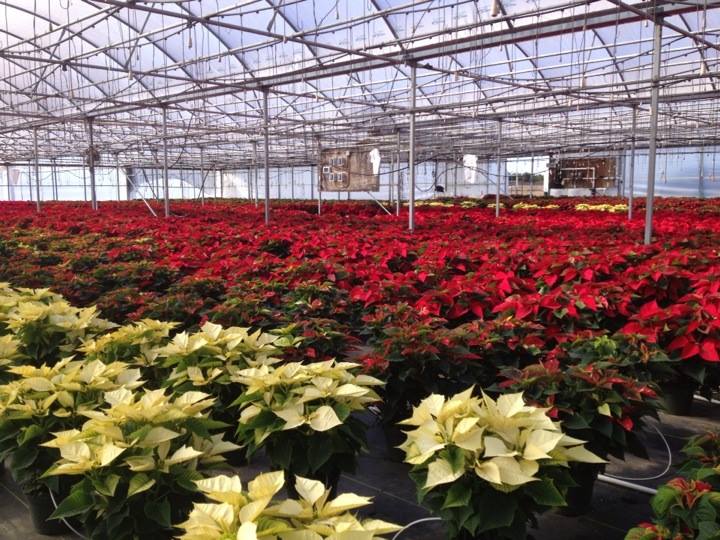
by Eddie Powell | Dec 9, 2014

Poinsettia grown in greenhouse
Photo Credits: William Wendt
The poinsettia is a beautiful plant associated with the Christmas holidays. These plants create colorful holiday decorations for any home. After the holidays are over, they can be used as landscape plants.
Poinsettias are non-poisonous and non-toxic. However, some people may be sensitive to the latex in poinsettia sap. Although eating even a large number of leaves will not result in illness, the plant is not considered edible. When used as an indoor plant, it should be kept out of reach of children and pets.
Keep your poinsettias away from drafts and chilly air. Water your poinsettia when the surface of the soil is dry to the touch. Place a saucer under the pot, and drain the saucer if water starts to collect in it. Keep the soil from getting soggy. Gently spray the plants with a mist sprayer or place them on gravel trays. Slightly humid air will help prolong the plants’ color and life span. Do not fertilize your indoor poinsettias until you are ready to move them outside. High levels of fertilizer will reduce the quality of the plant.
When the temperatures start to warm up in spring, trim the fading bracts. Leave 4 to 6 inches of the stem on each branch. Begin using a well-balanced fertilizer, and move the plant outdoors to a somewhat shaded area. Once the poinsettia has acclimated to the outdoors, plant it in an area that receives full sun most of the day. Keep in mind that to put out its colorful bracts, poinsettias require 14 hours of complete darkness each day for 6 to 8 weeks. Any interruption to this dark period can delay or prevent the plant from flowering.
Keep the soil moderately moist at all times. Poinsettias grow best in moist, well drained, fertile soils. The ideal soil pH range is 5.5 to 6.5, but the plants will tolerate a range from 5.0 and 7.0. Fertilize your outdoor poinsettias once a month. In north Florida, the plants should be fertilized between May and September.
In the landscape, prune your poinsettias in early spring after they are finished blooming, and when the danger of frost has passed. Cut them back to within 12 to 18 inches of the ground. If the plants have been frozen below this point, cut them back to the live wood. Pruning during the growing season will produce a compact plant at flowering time. After four weeks or when the new growth is 12 inches long, cut the plant back, leaving four leaves on each shoot.
For more information see: Poinsettias at a Glance
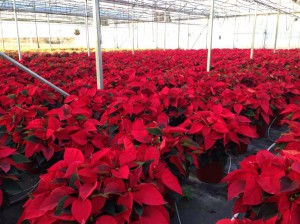
Poinsettia offers awesome Christmas color
Photo Credits: William Wendt















